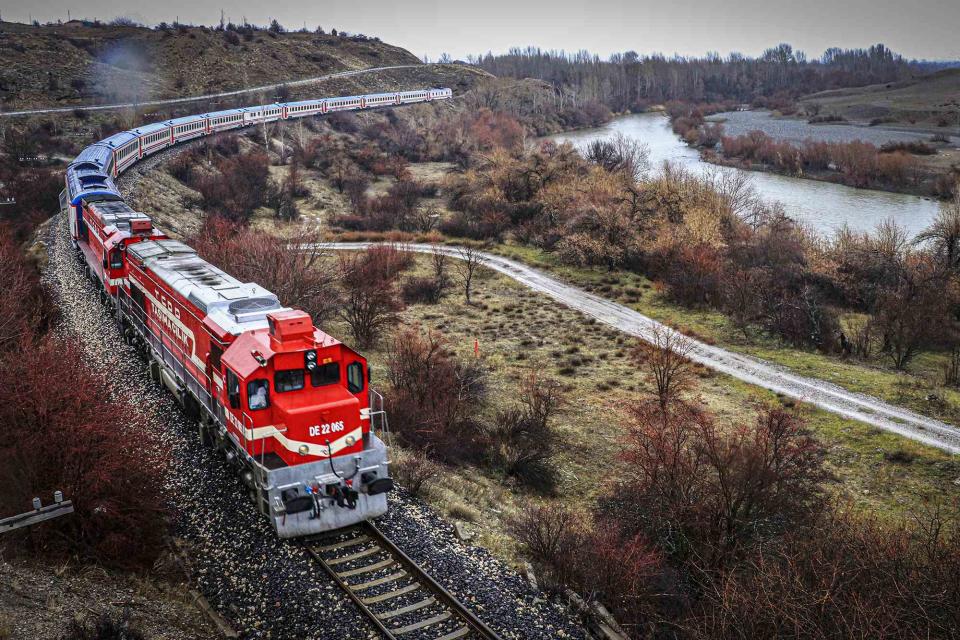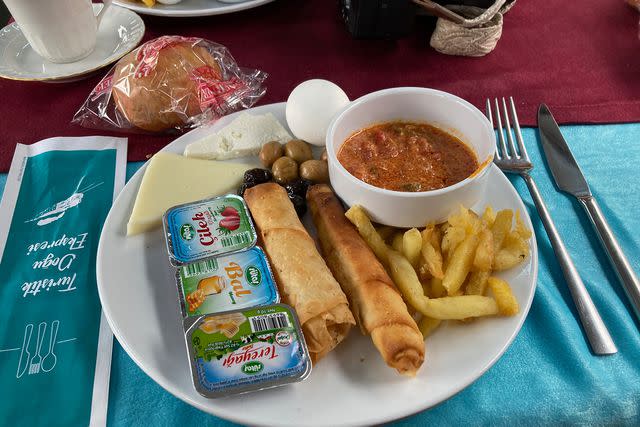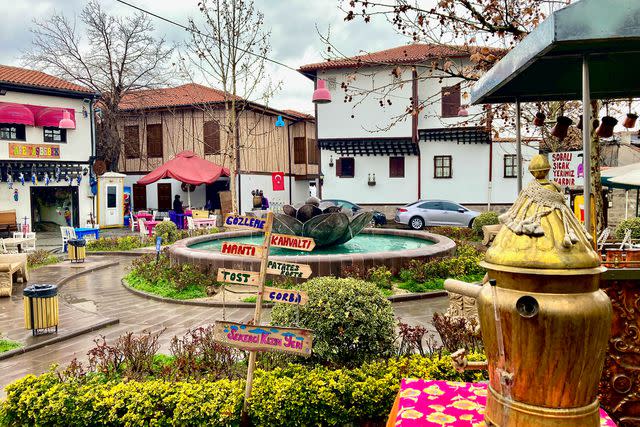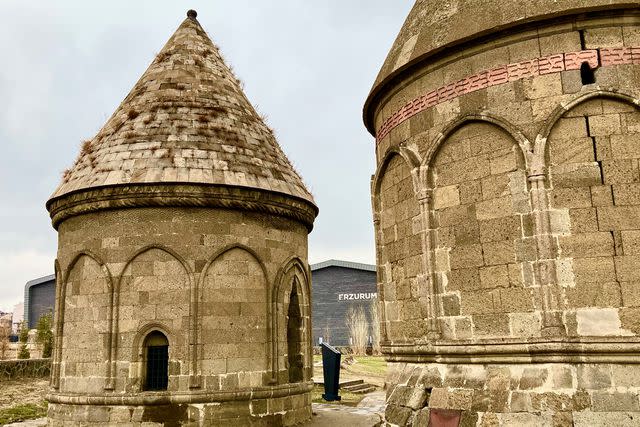This Scenic 30-hour Overnight Train Through Turkey Feels Like the Orient Express — but Costs Less Than $40
"You could almost say that where the Orient Express ends, the Eastern Express begins," writes a seasoned traveler who rode the overnight train for 814 miles this past spring.

Kemal Ozdemir/Getty Images
For about the price of a night’s stay at, say, the Holiday Inn Express in Le Claire, Iowa, a rail passenger can book a sleeper compartment for a 30-hour scenic ride in Turkey on one of the world’s fast-dwindling stock of overnight trains. You could almost say that where the Orient Express ends, the Eastern Express begins.
From Turkey’s capital of Ankara to Kars on the Armenian border, 814 miles away, the Turistik Doğu Ekspresi crosses the deep, river-carved canyons, broad plains, and snowy mountains of Anatolia, the Asian part of Turkey, and makes two stops along the way. Since the service began in 2019 (it was curtailed by the COVID-19 pandemic for most of 2020 and 2021), the two-person sleepers on the 30-hour ride sell out almost as soon as they go on sale, one month before departure.
The Turks are crazy about the Touristic Eastern Express. So are an increasing number of adventurous international travelers. I rode the Eastern Express this past spring — here's what you can expect on the mesmerizing 30-hour ride.
Rolling Out of Ankara
The Touristic Eastern Express will never be accused of high-speed railroading. Chugging out of Ankara Gari, the capital’s main station, into the late-afternoon vastness of the Central Anatolian plateau, the train’s DE22000 diesel locomotive rarely hit its max velocity of 75 mph. But for those on board, that’s a blessing, allowing for more time to watch the scenery roll by at a leisurely pace.
The train departs Ankara on Wednesday and Friday at 3:55 p.m. That left just enough sunlight for me to settle into my quarters and still have time to enjoy views of the passing isolated villages, sugar-beet farms and barley fields, tumble-down stone cottages, and white-capped mountains sweeping past the large windows.

Mark Orwoll
The compartments are cozy, not lavish. The TVS 2000 sleepers have an upholstered bench seat facing a cabinet with a minifridge, thoughtfully pre-stocked with bottled water and several chocolate bars. In the corner next to the lockable sliding door (key provided) is a wash basin as well as a mirror, light, and electrical outlet that accepts standard two-round-pin European plugs. A rack above the cabinet can hold two pieces of luggage, but there’s no closet for storage. The daytime bench seat converts to a single bed; an upper bunk above it folds down from the wall for a second person. Fresh linens, blankets, pillows, and slippers complete the room’s amenities.
Time to Festoon

Mark Orwoll
Most travelers keep their cabin doors open during waking hours, which lends a friendly, festive air to the train. Girlfriends on a weekend getaway, vacationing families, international backpackers, and couples on a romantic escape all gussy up their roomettes with strings of colored battery-powered lights, streamers, garlands, and other adornments. Children tape crayoned train drawings to the corridor walls and make soap artwork on the windows. Wine bottles begin to appear on the cabinet tops, and lively Turkish tunes emanate from personal speakers.
The dining car, with enough four-top tables to seat 48, serves breakfast, lunch, and dinner at a modest charge. The food is decent traditional Turkish cuisine (kebabs, stews, soups, and the like) heated in a microwave. As convenient as the diner may be, many passengers opt to bring their own victuals, which they spread lavishly across the tops of the cabinets in their sleepers.
As for boozy libations, none are sold on the train, but guests are free to bring their own on board.
Even the Night Holds Sights
Fans of long-distance trains know the attraction of an overnight stay in a sleeper. On my journey, a waning gibbous moon emerged from a cloudbank to enkindle a crag-pocked cliffside and wheatfields on rolling plains. Occasionally the train slowed through some third-tier town. The papaya-pulp glow of sodium lights on a remote station’s platform revealed the denizens of the wayside: disused open-top hoppers, empty coil cars, corroded gondolas, a modest village in the distance illumined by weak-yellow streetlamps.
A glass of dry Kalecik karasi red from Ankara Province, Cormac McCarthy’s "Blood Meridian" on the iPad, and the rumbling of the steel wheels on the tracks soon lulled me to sleep. Before going to bed, I asked a passing conductor about the best time to wake up for the scenery in the morning.
“Between Divriği and Erzincan,” the conductor replied. “We pass through a long canyon. The train track twists this way, then that way, then back again. So you’ll see the sun first on this side, then on that side. The view will be good in both directions. Be up with the sun.”
The early-risers and avid photographers set their alarms for dawn, at around 6 a.m., in preparation for sunrise some 30 minutes later.
A Fabled Route, Updated for the Curious Traveler

Mark Orwoll
The original Doğu Ekspresi, or Eastern Express, launched in 1936 from Istanbul to Çetinkaya, and was later extended to the ski-resort city of Erzurum. Turkish State Railways ultimately moved the train’s starting point to Ankara and its current terminus eastward to Kars in 1962. Despite the dramatic scenery, the Express operated more as a commuter vehicle than a scenic holiday train. It was full of business travelers, grandparents visiting grandkids, and young adults heading to or from university. There were standard coach seats (called Pullman seats in Turkey), shared four-person couchettes with pull-down beds, and a lone car with two-person private sleeper compartments. Station stops rarely lasted more than a quarter of an hour, and often were just a minute or two.
But in 2019, someone in the head office of Turkish State Railways had the idea to introduce a variant of the Eastern Express, a service that would be limited to two-person sleepers plus a restaurant car. It would travel only in the scenic wintertime, when the landscape was often coated in snow. The train would make stops for up to three hours in the two cities most worth visiting along the route. The ride would be lengthier than the original route, true — 30 hours instead of 24 — but with its all-sleeper service, the train would be even more comfortable for the passengers. And it would be labeled with the moniker Touristic Eastern Express.
Get Out Your Cameras
I woke to the glow of the sun through the compartment windows. By 6:30 a.m., the sun breached the horizon to reveal a stunning scene, far different from the one of the previous afternoon. A narrow high canyon boxed in the train on two sides. Where a four-lane highway had run alongside the tracks the night before, the wide, shallow, fast-running Western Euphrates River, also called the Firat, now paralleled the train.
Occasionally the canyon widened to give long views of snow-tinged pointy-topped mountains in the middle distance and gray filmy clouds resting just above the summits. An ancient double-arched stone bridge crossed the Euphrates, leading to an old Anatolian village full of tin roofs, muddy streets, and well-used tractors.
The Touristic Eastern Express’s first long stop is at Erzincan. Copper shoppers beeline for Yeralti Çarşisi, an underground bazaar in the heart of the modern city specializing in copperware. If there’s time, some take an early lunch of traditional kebabs, stews, mezes, and soups at the top-floor restaurant of the nearby Konak Mazlum Hotel. Many passengers instead simply wander through Erzincan’s streets and shops or choose a private tour of the photogenic multiple spillways of the nearby Girlevik Waterfalls.
Enticing Erzurum

Mark Orwoll
The train’s second long stop, four hours after leaving Erzincan, is at Erzurum, the largest settlement in Eastern Anatolia and one of Turkey’s highest cities, at an elevation of 6,400 feet. A winter-sports capital, with two universities, the thriving town is full of beeping traffic, sidewalks crowded with shoppers, skiers, and students, and rich with far more historic attractions than anyone can see during a three-hour layover. Find beehive-shaped mausoleums built in the 12th century for the city’s royal Seljuk families; historic houses, decorated in traditional style, open informally to visitors in exchange for a small cash donation; 1,000-year-old churches, madrassas, and mosques; and a jewelry bazaar, Rüstem Paşa Bedestini, that has operated continuously in its present location as a marketplace for more than 400 years. But the most important thing to do in Erzurum is eat cağ kebab, for which the city is famous.
The restaurant Muammer Usta, in the central shopping district, is a good example. To make the dish, meat from highland-raised sheep is marinated with salt, pepper, basil, and onions for 24 hours. Piece by piece, the slices of lamb are pressed tightly down onto an upright skewer, with plenty of tail fat slathered on the meat for additional flavor. Once the skewer can hold no more, it’s transferred to an open oakwood fire and laid horizontally above the flames. The meat is then roasted on the spit until it’s cooked through and the juices are flowing. Long thin slices are carved off by the chef and served to guests with lavash, a thin flatbread that’s more like a flour tortilla than the thick pita commonly served with, say, a doner kebab or gyro. With spicy chili sauce and lots of onions, wrapped burrito-like in the lavash, cağ kebab is a hearty and rich meal.
The End of the Line at Kars
Another four hours on the train leads to the terminus at Kars, a city that has been battled over by various empires for centuries. Today Kars is firmly in Turkish hands, despite the many black-basalt neoclassical buildings left by the Russians, who occupied the city from 1877 to 1917. Even the 1899 Kars Station, where the Turistik Doğu Ekspresi ends its run from Ankara, was built by the Czar’s engineers.
In the days ahead, guests planned visits to the clifftop Kars Castle, cheese tastings and a walk-through of the Cheese Museum (Kars is simply mad about cheese), and lunches at an all-goose restaurant (yes, goose meals; it’s a thing in Kars). There are also walking tours of the fascinating Czarist-era architecture, and options to wander through the ancient, abandoned city of Ani, close to Kars and just meters from the Armenian border.
The Touristic Eastern Express leaves twice weekly in both directions from December through March. (The commuter-oriented Eastern Express runs daily, but doesn’t make tour stops and has limited sleeper accommodations.) Tickets can be purchased one month before the departure date on the ticketing page of the TCDD website. The site, which can be converted to English, offers tickets from Ankara to Kars in July 2023 starting from $10. You can also book through an authorized Turkish travel agency, such as Amber Travel in Istanbul.
Mark Orwoll is the former international editor of Travel + Leisure, where he was on the staff for 30 years.
For more Travel & Leisure news, make sure to sign up for our newsletter!
Read the original article on Travel & Leisure.

